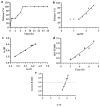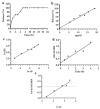Mathematical Models as Tools to Predict the Release Kinetic of Fluorescein from Lyotropic Colloidal Liquid Crystals
- PMID: 30813650
- PMCID: PMC6427212
- DOI: 10.3390/ma12050693
Mathematical Models as Tools to Predict the Release Kinetic of Fluorescein from Lyotropic Colloidal Liquid Crystals
Abstract
In this study, we investigated the release kinetic of fluorescein from colloidal liquid crystals made from monoglyceride and different non-ionic surfactants. The crystals were physicochemically characterized and the release experiments were carried out under the sink conditions, while mathematical models were described as extrapolations from solutions of the diffusion equation, in different initial and boundary conditions imposed by pharmaceutical formulations. The diffusion equation was solved using Laplace and Fourier transformed functions for release kinetics from infinite reservoirs in a semi-infinite medium. Solutions represents a general square root law and can be applied for the release kinetic of fluorescein from lyotropic colloidal liquid crystals. Akaike, Schwartz, and Imbimbo criteria were used to establish the appropriate mathematical model and the hierarchy of the performances of different models applied to the release experiments. The Fisher statistic test was applied to obtain the significance of differences among mathematical models. Differences of mathematical criteria demonstrated that small or no significant statistic differences were carried out between the various applied models and colloidal formulations. Phenomenological models were preferred over the empirical and semi-empirical ones. The general square root model shows that the diffusion-controlled release of fluorescein is the mathematical models extrapolated for lyotropic colloidal liquid crystals.
Keywords: drug delivery systems; lyotropic colloidal liquid crystals; mathematical models; release kinetic; release profile; square root laws.
Conflict of interest statement
The authors declare no conflict of interest. The funders had no role in the design of the study; in the collection, analyses, or interpretation of data; in the writing of the manuscript, and in the decision to publish the results.
Figures






Similar articles
-
Development and In Vitro Evaluation of Lyotropic Liquid Crystals for the Controlled Release of Dexamethasone.Polymers (Basel). 2017 Aug 2;9(8):330. doi: 10.3390/polym9080330. Polymers (Basel). 2017. PMID: 30971006 Free PMC article.
-
Phase transition and release kinetics of polyphenols encapsulated lyotropic liquid crystals.Int J Pharm. 2019 Jun 30;565:283-293. doi: 10.1016/j.ijpharm.2019.05.021. Epub 2019 May 10. Int J Pharm. 2019. PMID: 31078646
-
Mathematical Modeling of Release Kinetics from Supramolecular Drug Delivery Systems.Pharmaceutics. 2019 Mar 21;11(3):140. doi: 10.3390/pharmaceutics11030140. Pharmaceutics. 2019. PMID: 30901930 Free PMC article. Review.
-
Modeling and analysis of dispersed-drug release into a finite medium from sphere ensembles with a boundary layer.J Control Release. 2003 Jun 5;90(1):23-36. doi: 10.1016/s0168-3659(03)00128-7. J Control Release. 2003. PMID: 12767704
-
Controlling molecular transport and sustained drug release in lipid-based liquid crystalline mesophases.J Control Release. 2014 Aug 28;188:31-43. doi: 10.1016/j.jconrel.2014.05.052. Epub 2014 Jun 6. J Control Release. 2014. PMID: 24910192 Review.
Cited by
-
Oral Drug Delivery via Intestinal Lymphatic Transport Utilizing Lipid-Based Lyotropic Liquid Crystals.Liquids (Basel). 2023 Dec;3(4):456-468. doi: 10.3390/liquids3040029. Epub 2023 Nov 20. Liquids (Basel). 2023. PMID: 38711572 Free PMC article.
-
Doxorubicin Hydrochloride-Loaded Nonionic Surfactant Vesicles to Treat Metastatic and Non-Metastatic Breast Cancer.ACS Omega. 2021 Jan 22;6(4):2973-2989. doi: 10.1021/acsomega.0c05350. eCollection 2021 Feb 2. ACS Omega. 2021. PMID: 33553916 Free PMC article.
-
Development of amphiphilic self-assembled nucleolipid as BBB targeting probe based on SPECT.Discov Nano. 2024 Dec 18;19(1):210. doi: 10.1186/s11671-024-04129-y. Discov Nano. 2024. PMID: 39690348 Free PMC article.
-
Impact of Surface Properties of Core Material on the Stability of Hot Melt-Coated Multiparticulate Systems.Pharmaceutics. 2021 Mar 10;13(3):366. doi: 10.3390/pharmaceutics13030366. Pharmaceutics. 2021. PMID: 33802098 Free PMC article.
-
Curcumin-Based β-Diketo Ligands for Ga3+: Thermodynamic Investigation of Potential Metal-Based Drugs.Pharmaceuticals (Basel). 2022 Jul 12;15(7):854. doi: 10.3390/ph15070854. Pharmaceuticals (Basel). 2022. PMID: 35890151 Free PMC article.
References
LinkOut - more resources
Full Text Sources

